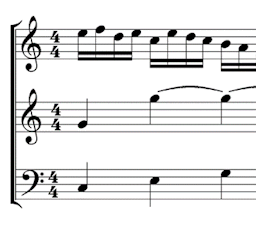3-Part Texture
Most of the harmony rules we have learned up to now have been based on 4-part, SATB harmony. Music can, of course, be written for any number of parts, and in this lesson we will look at the way harmony works when there are only three parts. Music written for 3-parts will normally be written either as SSB, SAB or STB .
In this lesson I’ll focus on SSB style, using examples from the Trio Sonata format. Because there are two soprano parts, it is quite normal for these parts to cross each other. Some rules of harmony, (such as the treatment of the harmonic diminished 5th), depend on the outer two parts, so it is important to be aware of which of the two upper parts is the higher one at any particular time.
In this extract from Corelli’s Trio Sonata op.4 no.5, notice that the upper two parts cross briefly, and also end on a unison/octave.
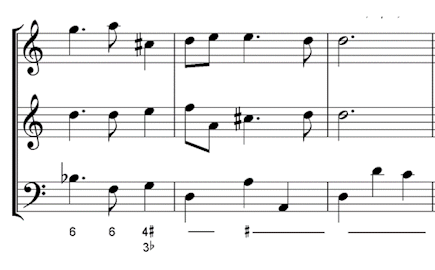
Leading notes
We have already learned that the normal voice leading behaviour of the leading note is to rise by step, if the chord progression is V-I, but that in a 4-part SATB piece, the leading note can alternatively move to the dominant, if the leading note appears in one of the two inner parts: the alto or the tenor.
In three-part textures like a Baroque Trio Sonata, there is only one inner part. If the leading note is in the inner part and falls to the dominant, the dominant note tends to sound too strong. For this reason, in all three-part music, the leading note should usually rise by step, even though the resulting tonic-chord has its 5th omitted.

7ths
In added 7th chords (e.g. V7, ii7, vii°7 etc.), the 7th should normally fall by step when the harmony changes. In V7c (V4/3), the 7th may, alternatively, rise by step.
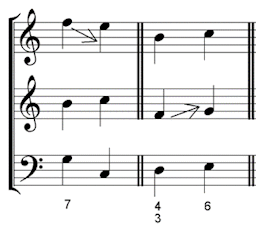
Because 7th chords are 4-note chords, we often have to omit one chord note in a 3-part texture. The sounds of the chords are a little different:
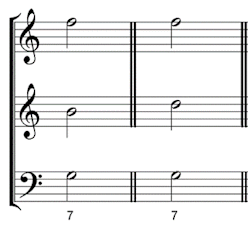
However, if you are writing in a Baroque style with harpsichord continuo part, remember that the entire chord would be filled out by the continuo player’s improvised accompaniment, in any case.
Consecutive 8ves and 5ths
At this stage you should be able to easily spot a basic consecutive 5th or 8ve, which are also known as parallel 5ths or octaves.
You need to avoid consecutive 5ths and octaves between any pair of parts, which means you need to keep an eye on the top and middle, top and bottom, and middle and bottom parts as pairs.

There can be situations where 5ths sit in a “grey area”. The rules are not quite the same if there is a diminished 5th involved, or if the 5th is made with the middle part. It can be confusing to know what’s wrong and what’s acceptable, so here’s a quick overview of what to consider.
- Consecutive perfect 5ths between the top and bottom parts should always be avoided.
- If the middle part is involved, there might be times when they are not problematic if the 5ths are in contrary motion, for example in this trio by Corelli.
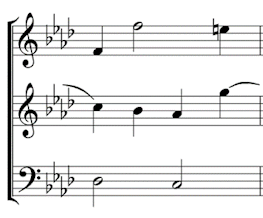
The strength of the individual melodies at this point, (because of the octave leap, in contrary motion) means that they sound very independent.
The reason why consecutives are usually forbidden is that the two parts blend together too much. Because of the laws of acoustics, a perfect 5th can sound very close to a single note, rather than two distinct notes. Consecutives destroy the individual independence of each part; but if something else in the music increasesthe independence of the part, the consecutives might be acceptable.
- If the middle part is involved, it is usually ok for a perfect 5th to move to a diminished 5th, but not the other way round.
- If the 5ths are between the top and bottom parts, even moving to a diminished 5th can sound awkward.
In an exam situation it can be difficult to know what, if any, exceptions might be ok, so my advice to you is to avoid all consecutives to be on the safe side. But, if you come across any while you are playing or studying Baroque music, see if you can think of a reason why they might be acceptable in that particular case.
Exposed/Hidden/Concealed 5ths and Octaves
As well as normal consecutives, you should also keep an eye out for “concealed” or “exposed” 5ths and octaves. Although these two names sound like opposites, they’re actually the same thing! They are concealed because they are hard to see, but they are exposed because they are easy to hear.
Exposed 5ths and octaves happen when the highest sounding part leaps in the same direction as the bass, and moves into a perfect 5th or octave with the bass.
Here is an example of an exposed octave. The highest part, which happens to be the middle part here, leaps to G on the 3rd beat, which is an octave above the bass. It moves in similar motion with the bass, because both parts are rising.
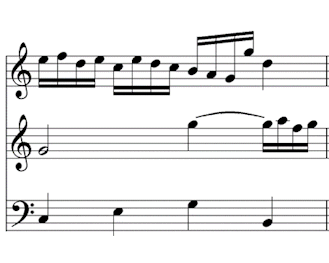
We could fix this by making the middle part leap up to G on the previous beat instead. This will remove the similar motion into an octave, because the middle part is now stationary when the bass moves to G.
